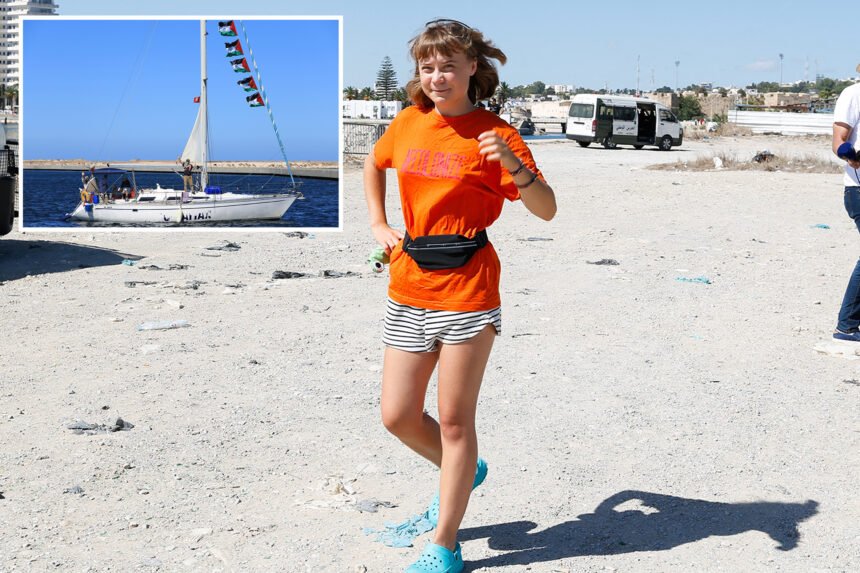Greta Thunberg Joins Gaza-Bound Flotilla Amid Controversy
In a striking display of activism, Greta Thunberg, the renowned Swedish climate activist, made headlines once again as she boarded the Global Sumud Flotilla in Bizerte, Tunisia, on Saturday. Clad in turquoise Crocs and a fanny pack, Thunberg’s appearance has drawn both admiration and criticism, particularly from Israeli officials who have derisively labeled the mission a “selfie yacht.”
The Global Sumud Flotilla: A Humanitarian Mission
The Global Sumud Flotilla aims to deliver humanitarian supplies to the besieged Gaza Strip, asserting its intention to break the longstanding Israeli blockade. Organizers claim that the flotilla comprises over 40 vessels and nearly 700 activists from 40 different countries, as reported by Turkey’s state-run Anadolu news agency. This ambitious initiative is being touted as the largest humanitarian maritime convoy ever attempted.
Thunberg, who has become a global icon for climate activism, expressed her outrage at the current state of affairs in Gaza. “I am absolutely disgusted and appalled to live in a world where our people in power, every day, are betraying Palestinians,” she stated while aboard the flotilla. Her comments reflect a growing sentiment among activists who believe that the plight of Palestinians is often overlooked in international discourse.
Historical Context: The Gaza Blockade
The Israeli blockade of Gaza has been a contentious issue for over a decade. Initially imposed in 2007 after Hamas took control of the territory, the blockade was justified by Israel as a necessary measure to prevent the smuggling of weapons. However, critics argue that it has led to severe humanitarian crises, with restrictions on essential goods and services affecting the daily lives of Gaza’s residents.
The situation escalated dramatically following the Hamas attacks on October 7, which resulted in the deaths of 1,200 Israelis and the abduction of over 250 individuals. In response, Israel intensified its blockade, further complicating the humanitarian situation in Gaza. This backdrop adds a layer of urgency to the flotilla’s mission, as activists seek to draw attention to the ongoing suffering of the Palestinian people.
Thunberg’s Previous Encounter with Israeli Forces
This is not Thunberg’s first attempt to reach Gaza by sea. In June, she was part of a flotilla that was intercepted by the Israeli navy, which subsequently deported her. Israeli officials mocked the mission, branding it a “selfie yacht” cruise, and emphasized that there are more effective ways to deliver aid to Gaza without resorting to social media spectacles. “There are ways to deliver aid to the Gaza Strip – they do not involve Instagram selfies,” stated Israel’s Foreign Ministry at the time.
The Israeli government has consistently criticized such flotillas, arguing that they serve more as publicity stunts than genuine humanitarian efforts. This skepticism is rooted in a broader narrative that questions the effectiveness of international activism in addressing the complex realities on the ground.
Recent Challenges Faced by the Flotilla
The Global Sumud Flotilla has already encountered significant obstacles. Just two weeks prior to Thunberg’s boarding, the convoy set sail from Barcelona but was forced to return to port due to severe weather conditions, with winds reaching up to 35 mph. Such setbacks highlight the logistical challenges faced by activists attempting to navigate the Mediterranean Sea, particularly in a politically charged environment.
Despite these hurdles, flotilla organizers remain resolute in their mission. They assert that their efforts are crucial in raising awareness about the humanitarian crisis in Gaza and in challenging the Israeli blockade. The flotilla’s determination to proceed, even in the face of adversity, underscores the commitment of many activists to advocate for Palestinian rights.
The Broader Implications of the Flotilla
The Global Sumud Flotilla is not merely a maritime endeavor; it represents a broader movement advocating for Palestinian rights and humanitarian aid. The involvement of high-profile activists like Thunberg brings increased visibility to the cause, but it also raises questions about the effectiveness of such actions in achieving tangible results.
Historically, maritime convoys aimed at breaking blockades have been met with mixed outcomes. While they often succeed in drawing international attention, the actual impact on the ground can be limited. The Israeli government has repeatedly emphasized that it prioritizes security concerns over humanitarian gestures, complicating the narrative surrounding such initiatives.
Conclusion: A Complex Landscape of Activism
As Greta Thunberg embarks on this latest journey, the Global Sumud Flotilla stands at the intersection of humanitarian advocacy and geopolitical tensions. While the mission aims to deliver much-needed supplies to Gaza, it also serves as a flashpoint for broader discussions about the Israeli-Palestinian conflict, international activism, and the role of social media in modern protests.
The flotilla’s progress will be closely monitored, not only for its potential impact on the humanitarian situation in Gaza but also for the conversations it sparks around the effectiveness of activism in a world increasingly defined by complex political realities. As the flotilla sets sail, the eyes of the world will be watching, eager to see how this bold initiative unfolds.











